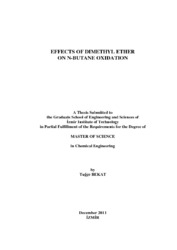Please use this identifier to cite or link to this item:
https://hdl.handle.net/11147/3181Full metadata record
| DC Field | Value | Language |
|---|---|---|
| dc.contributor.advisor | İnal, Fikret | - |
| dc.contributor.author | Bekat, Tuğçe | - |
| dc.date.accessioned | 2014-07-22T13:51:02Z | - |
| dc.date.available | 2014-07-22T13:51:02Z | - |
| dc.date.issued | 2011 | - |
| dc.identifier.uri | http://hdl.handle.net/11147/3181 | - |
| dc.description | Thesis (Master)--Izmir Institute of Technology, Chemical Engineering, Izmir, 2011 | en_US |
| dc.description | Includes bibliographical references (leaves: 129-133) | en_US |
| dc.description | Text in English; Abstract: Turkish and English | en_US |
| dc.description | xiv, 160 leaves | en_US |
| dc.description.abstract | Effects of dimethyl ether on the oxidation of n-butane were investigated using Detailed Chemical Kinetic Modeling approach. Oxidation process was carried out in a tubular reactor under laminar flow conditions. The formations of various oxidation products, especially toxic species were investigated for the addition of dimethyl ether in different mole fractions to n-butane. Pure dimethyl ether oxidation was also investigated for comparison. Pure dimethyl ether oxidation resulted in lower mole fractions of carbon monoxide, methane, acetaldehyde and aromatic species, but higher mole fractions of formaldehyde when compared to pure n-butane oxidation. The addition of dimethyl ether to n-butane in different mole fractions was observed to decrease mole fractions of acetaldehyde and aromatic species and increase the mole fraction of formaldehyde, while other toxic species investigated were not affected significantly. The effects of three important process parameters on the formations of oxidation products were also investigated. Inlet temperatures between 500 and 1700 K, pressures of 1 and 5 atm, and equivalence ratios of 2.6 and 3.0 were studied. Increasing pressure and equivalence ratio were observed to increase the mole fractions of toxic species in general. The effect of temperature was more complicated depending on the species and the temperature interval. Reaction path analysis indicated that the most important precursors playing role in the formation of the first ring benzene were acetylene, ethylene, propargyl, allene, allyl, propene and fulvene during n-butane/dimethyl ether oxidation. Finally, a skeletal chemical kinetic mechanism was developed and validated for the oxidation of n-butane/dimethyl ether mixture. | en_US |
| dc.language.iso | en | en_US |
| dc.publisher | Izmir Institute of Technology | en_US |
| dc.rights | info:eu-repo/semantics/openAccess | en_US |
| dc.subject.lcsh | Methyl ether | en |
| dc.subject.lcsh | Butane | en |
| dc.subject.lcsh | Oxidation | en |
| dc.subject.lcsh | Chemical kinetics--Mathematical models | en |
| dc.subject.lcsh | Aromatic compounds | en |
| dc.subject.lcsh | Hydrocarbons | en |
| dc.title | Effects of Dimethyl Ether on N-Butane Oxidation | en_US |
| dc.type | Master Thesis | en_US |
| dc.institutionauthor | Bekat, Tuğçe | - |
| dc.department | Thesis (Master)--İzmir Institute of Technology, Chemical Engineering | en_US |
| dc.relation.publicationcategory | Tez | en_US |
| dc.identifier.wosquality | N/A | - |
| dc.identifier.scopusquality | N/A | - |
| item.openairecristype | http://purl.org/coar/resource_type/c_18cf | - |
| item.languageiso639-1 | en | - |
| item.openairetype | Master Thesis | - |
| item.grantfulltext | open | - |
| item.fulltext | With Fulltext | - |
| item.cerifentitytype | Publications | - |
| Appears in Collections: | Master Degree / Yüksek Lisans Tezleri | |
Files in This Item:
| File | Description | Size | Format | |
|---|---|---|---|---|
| T001000.pdf | MasterThesis | 4.19 MB | Adobe PDF |  View/Open |
CORE Recommender
Page view(s)
240
checked on Mar 31, 2025
Download(s)
218
checked on Mar 31, 2025
Google ScholarTM
Check
Items in GCRIS Repository are protected by copyright, with all rights reserved, unless otherwise indicated.